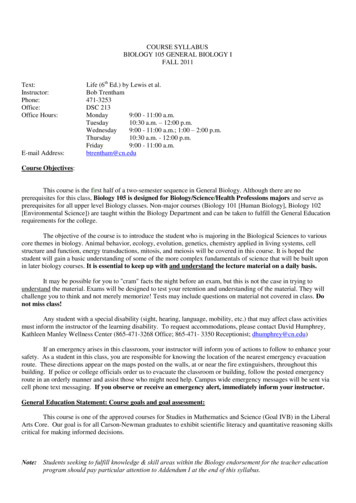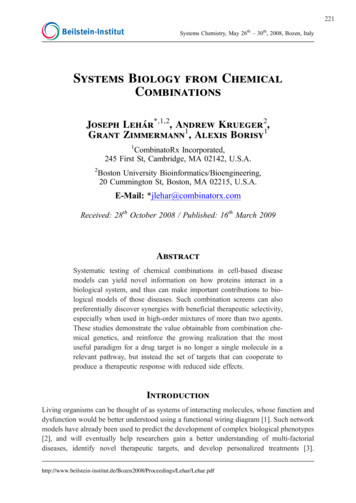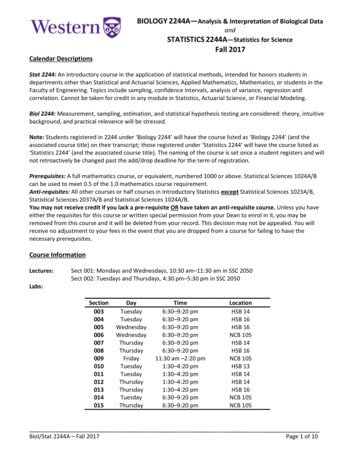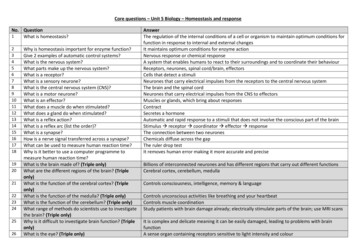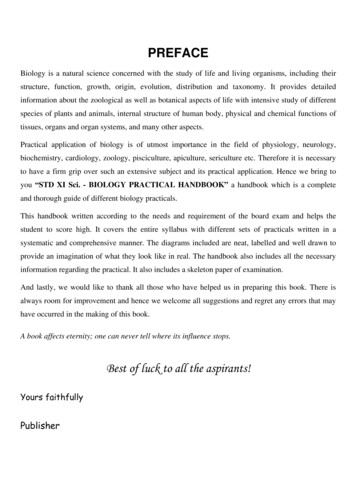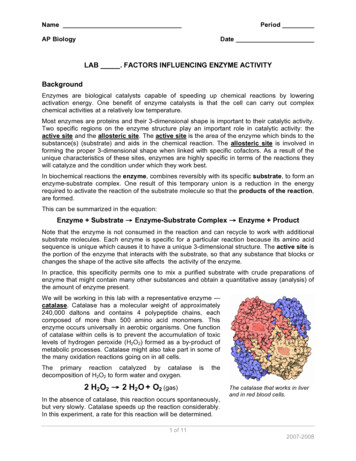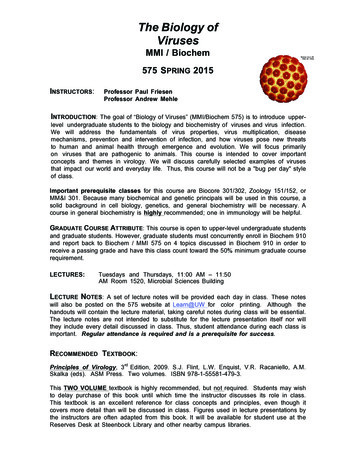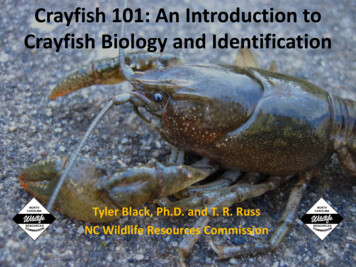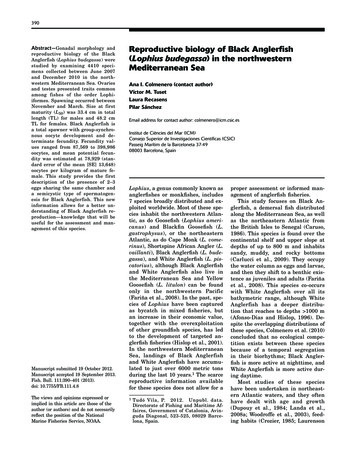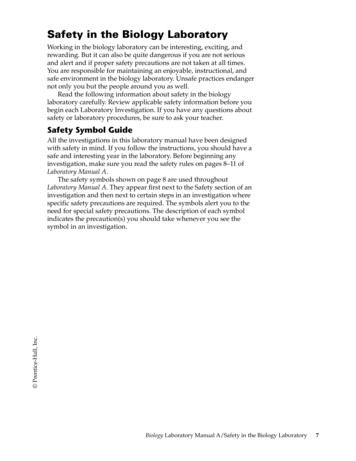
Transcription
Safety in the Biology LaboratoryWorking in the biology laboratory can be interesting, exciting, andrewarding. But it can also be quite dangerous if you are not seriousand alert and if proper safety precautions are not taken at all times.You are responsible for maintaining an enjoyable, instructional, andsafe environment in the biology laboratory. Unsafe practices endangernot only you but the people around you as well.Read the following information about safety in the biologylaboratory carefully. Review applicable safety information before youbegin each Laboratory Investigation. If you have any questions aboutsafety or laboratory procedures, be sure to ask your teacher.Safety Symbol Guide Prentice-Hall, Inc.All the investigations in this laboratory manual have been designedwith safety in mind. If you follow the instructions, you should have asafe and interesting year in the laboratory. Before beginning anyinvestigation, make sure you read the safety rules on pages 8–11 ofLaboratory Manual A.The safety symbols shown on page 8 are used throughoutLaboratory Manual A. They appear first next to the Safety section of aninvestigation and then next to certain steps in an investigation wherespecific safety precautions are required. The symbols alert you to theneed for special safety precautions. The description of each symbolindicates the precaution(s) you should take whenever you see thesymbol in an investigation.Biology Laboratory Manual A/Safety in the Biology Laboratory7
Safety SymbolsLaboratory Apron Wear a laboratoryapron to protect your skin and clothing.Breakage You are working with breakable materials, such as glassware. Handle breakable materials with care. Do nottouch broken glassware.Heat-resistant Gloves Use hand protection when handling hot materials. Hotequipment or hot water can cause burns. Donot touch hot objects with your bare hands.Plastic Gloves Wear disposable plasticgloves to protect yourself from chemicalsor organisms that could be harmful. Keepyour hands away from your face. Dispose ofthe gloves according to your teacher’sinstructions at the end of the activity.Heating Use a clamp or tongs to pick uphot glassware. Do not touch hot objectswith your bare hands.Sharp Object Pointed-tip scissors, scalpels,knives, needles, pins, or tacks can cut orpuncture your skin. Always direct a sharpedge or point away from yourself and others.Use sharp instruments only as directed.Electric Shock Avoid the possibility ofelectric shock. Never use electrical equipment around water, or when equipment iswet or your hands are wet. Be sure cords areuntangled and cannot trip anyone. Disconnect the equipment when it is not in use.Corrosive Chemical Avoid gettingacids or other corrosive chemicals onyour skin or clothing, or in your eyes. Do notinhale the vapors. Wash your hands whenyou are finished with the activity.Poison Do not let any poisonous chemical come in contact with your skin, anddo not inhale its vapors. Wash your handswhen you are finished with the activity.8Biology Laboratory Manual A/Safety SymbolsPhysical Safety When an experimentinvolves physical activity, take precautions to avoid injuring yourself or others. Follow instructions from your teacher. Alertyour teacher if there is any reason you shouldnot participate in the activity.Animal Safety Treat live animals withcare to avoid harming the animals oryourself. Working with animal parts or preserved animals also may require caution.Wash your hands when you are finished.Plant Safety Handle plants only asdirected by your teacher. If you are allergic to certain plants, tell your teacher beforedoing an activity in which plants are used.Avoid touching poisonous plants or plantswith thorns. Wash your hands when you arefinished with the activity.Flames You may be working withflames from a Bunsen burner, candle, ormatches. Tie back loose hair and clothing.Follow instructions from your teacher aboutlighting and extinguishing flames.No Flames Flammable materials maybe present. Make sure no flames, sparks,or exposed heat sources are present.Fumes When poisonous or unpleasantvapors may be involved, work in a ventilated area. Avoid inhaling vapors directly.Only test an odor when directed to do so byyour teacher, and use a wafting motion todirect the vapor toward your nose.Disposal Chemicals and other usedmaterials must be disposed of safely.Follow the instructions from your teacher.Hand Washing Wash your hands thoroughly. Use antibacterial soap and warmwater. Lather both sides of your hands andbetween your fingers. Rinse well.General Safety Awareness You may seethis symbol when none of the other symbols appears. In this case, follow the specificinstructions provided. You may also see thissymbol when you are asked to develop yourown procedure. Have your teacher approveyour plan before you go further. Prentice-Hall, Inc.These symbols alert you to possible dangers.Safety Goggles Always wear safetygoggles to protect your eyes in any activity involving chemicals, flames, or heating, orthe possibility of broken glassware.
Science Safety RulesOne of the first things a scientist learns is thatworking in the laboratory can be an excitingexperience. But the laboratory can also bequite dangerous if proper safety rules are notfollowed at all times. To prepare yourself fora safe year in the laboratory, read over the following safety rules. Then read them a secondtime. Make sure you understand each rule. Ifyou do not, ask your teacher to explain anyrules you are unsure of. Prentice-Hall, Inc.Dress Code1. Many materials in the laboratory cancause eye injury. To protect yourself frompossible injury, wear safety goggleswhenever you are working with chemicals, burners, or any substance that mightget into your eyes. Never wear contactlenses in the laboratory.2. Wear a laboratory apron or coat whenever you are working with chemicals orheated substances.3. Tie back long hair to keep your hair awayfrom any chemicals, burners and candles,or other laboratory equipment.4. Remove or tie back any article of clothingor jewelry that can hang down and touchchemicals and flames. Do not wear sandals or open-toed shoes in the laboratory.Never walk around the laboratory barefoot or in stocking feet.General Safety Rules5. Be serious and alert when working in thelaboratory. Never “horse around” in thelaboratory.6. Be prepared to work when you arrive inthe laboratory. Be sure that you understand the procedure to be employed inany laboratory investigation and the possible hazards associated with it.7. Read all directions for an investigationseveral times. Follow the directionsexactly as they are written. If you are indoubt about any part of the investigation,ask your teacher for assistance.8. Never perform activities that are notauthorized by your teacher. Obtain permission before “experimenting” on yourown.9. Never handle any equipment unless youhave specific permission.10. Take extreme care not to spill any material in the laboratory. If spills occur, askyour teacher immediately about theproper cleanup procedure. Never simplypour chemicals or other substances intothe sink or trash container.11. Never eat or taste anything or apply cosmetics in the laboratory unless directed todo so. This includes food, drinks, candy,and gum, as well as chemicals. Wash yourhands before and after performing everyinvestigation.12. Know the location and proper use ofsafety equipment such as the fire extinguisher, fire blanket, first-aid kit, safetyshower, and eyewash station.13. Notify your teacher of any medical problems you may have, such as allergies orasthma.14. Keep your laboratory area clean andfree of unnecessary books, papers, andequipment.First Aid15. Report all accidents, no matter howminor, to your teacher immediately.16. Learn what to do in case of specific accidents such as getting acid in your eyes oron your skin. (Rinse acids off your bodywith lots of water.)17. Become aware of the location of the firstaid kit. Your teacher should administerany required first aid due to injury. Oryour teacher may send you to the schoolnurse or call a physician.18. Know where and how to report an accident or fire. Find out the location of thefire extinguisher, phone, and fire alarm.Keep a list of important phone numberssuch as the fire department and schoolBiology Laboratory Manual A/Science Safety Rules9
Heating and Fire Safety19. Never use a heat source such as a candleor burner without wearing safety goggles.20. Never heat a chemical you are notinstructed to heat. A chemical that isharmless when cool can be dangerouswhen heated.21. Maintain a clean work area and keep allmaterials away from flames.22. Never reach across a flame.23. Make sure you know how to light a Bunsen burner. (Your teacher will demonstratethe proper procedure for lighting a burner.)If the flame leaps out of a burner towardyou, turn the gas off immediately. Do nottouch the burner. It may be hot. And neverleave a lighted burner unattended.29. Use only those chemicals needed in theinvestigation. Keep all lids closed when achemical is not being used. Notify yourteacher whenever chemicals are spilled.30. Dispose of all chemicals as instructed byyour teacher. To avoid contamination,never return chemicals to their originalcontainers.31. Be extra careful when working with acidsor bases. Pour such chemicals over thesink, not over your work bench.32. When diluting an acid, pour the acid intowater. Never pour water into the acid.33. Rinse any acids off your skin or clothingwith water. Immediately notify yourteacher of any acid spill.27. Never mix chemicals for the “fun of it.”You might produce a dangerous, possiblyexplosive, substance.Using Glassware Safely34. Never force glass tubing into a rubberstopper. A turning motion and lubricantwill be helpful when inserting glass tubing into rubber stoppers or rubber tubing.Your teacher will demonstrate the properway to insert glass tubing.35. Never heat glassware that is not thoroughly dry. Use a wire screen to protectglassware from any flame.36. Keep in mind that hot glassware will notappear hot. Never pick up glasswarewithout first checking to see if it is hot.37. If you are instructed to cut glass tubing,fire polish the ends immediately toremove sharp edges.38. Never use broken or chipped glassware.If glassware breaks, notify your teacherand dispose of the glassware in theproper trash container.39. Never eat or drink from laboratory glassware. Clean glassware thoroughly beforeputting it away.28. Never touch, taste, or smell a chemical thatyou do not know for a fact is harmless.Many chemicals are poisonous. If you areinstructed to note the fumes in an investigation, gently wave your hand over theopening of a container and direct thefumes toward your nose. Do not inhale thefumes directly from the container.Using Sharp Instruments40. Handle scalpels or razor blades withextreme care. Never cut material towardyou; cut away from you.41. Be careful when handling sharp, pointedobjects such as scissors, pins, and dissecting probes.24. Point a test tube or bottle that is beingheated away from you and others. Chemicals can splash or boil out of a heated testtube.25. Never heat a liquid in a closed container.The expanding gases produced may blowthe container apart, injuring you or others.26. Never pick up a container that has beenheated without first holding the back ofyour hand near it. If you can feel the heaton the back of your hand, the containermay be too hot to handle. Use a clamp,tongs, or heat-resistant gloves when handling hot containers.Using Chemicals Safely10Biology Laboratory Manual A/Science Safety Rules Prentice-Hall, Inc.nurse near the phone. Report any fires toyour teacher at once.
42. Notify your teacher immediately if youcut yourself or receive a cut.End-of-Investigation Rules50. When an investigation is completed,clean up your work area and return allequipment to its proper place.51. Wash your hands after every investigation.52. Turn off all burners before leaving thelaboratory. Check that the gas line leading to the burner is off as well. Prentice-Hall, Inc.Handling Living Organisms43. No investigations that will cause pain,discomfort, or harm to mammals, birds,reptiles, fish, and amphibians should bedone in the classroom or at home.44. Treat all living things with care andrespect. Do not touch any organism in theclassroom or laboratory unless given permission to do so. Many plants are poisonous or have thorns, and even tameanimals may bite or scratch if alarmed.45. Animals should be handled only if necessary. If an animal is excited or frightened,pregnant, feeding, or with its young, special handling is required.46. Your teacher will instruct you as to howto handle each species that may bebrought into the classroom.47. Treat all microorganisms as if they wereharmful. Use antiseptic procedure, asdirected by your teacher, when workingwith microbes. Dispose of microbes asyour teacher directs.48. Clean your hands thoroughly after handling animals or the cage containinganimals.49. Wear gloves when handling small mammals. Report animal bites or stings toyour teacher at once.Biology Laboratory Manual A/Science Safety Rules 11
Safety ContractOnce you have read all the safety information on pages 7–11 inLaboratory Manual A and are sure you understand all the rules, fill outthe safety contract that follows. Signing this contract tells your teacherthat you are aware of the rules of the laboratory. Return your signedcontract to your teacher. You will not be allowed to work in thelaboratory until you have returned your signed contract.SAFETY CONTRACTI,, have read theSafety in the Biology Laboratory section on pages 7–11 in BiologyLaboratory Manual A. I understand its contents completely, and agree tofollow all the safety rules and guidelines that have been established ineach of the following areas:Dress CodeUsing Glassware SafelyGeneral Safety RulesUsing Sharp InstrumentsFirst AidHandling Living OrganismsHeating
Safety Symbols These symbols alert you to possible dangers. Safety GogglesAlways wear safety goggles to protect your eyes in any activ-ity involving chemicals
